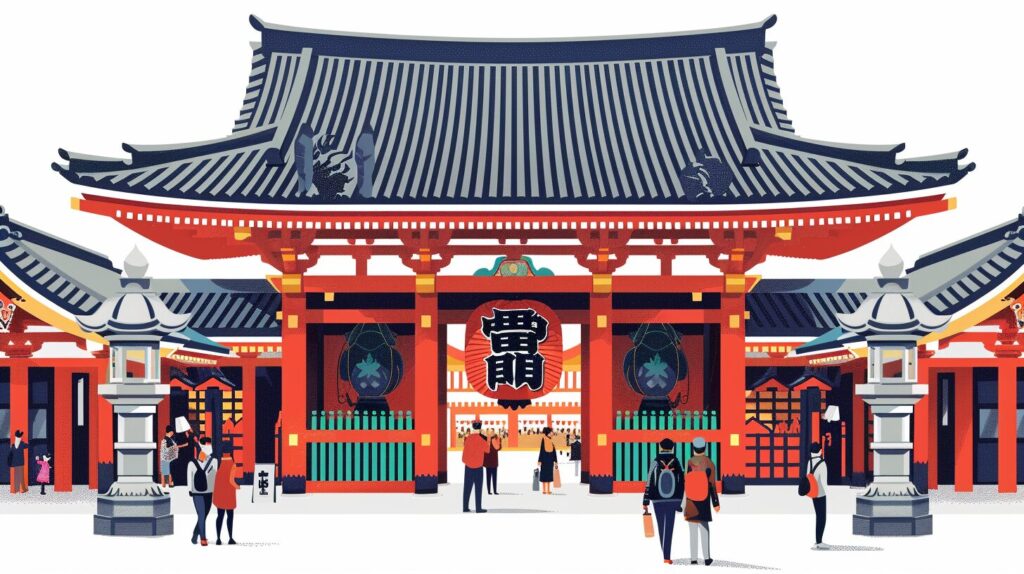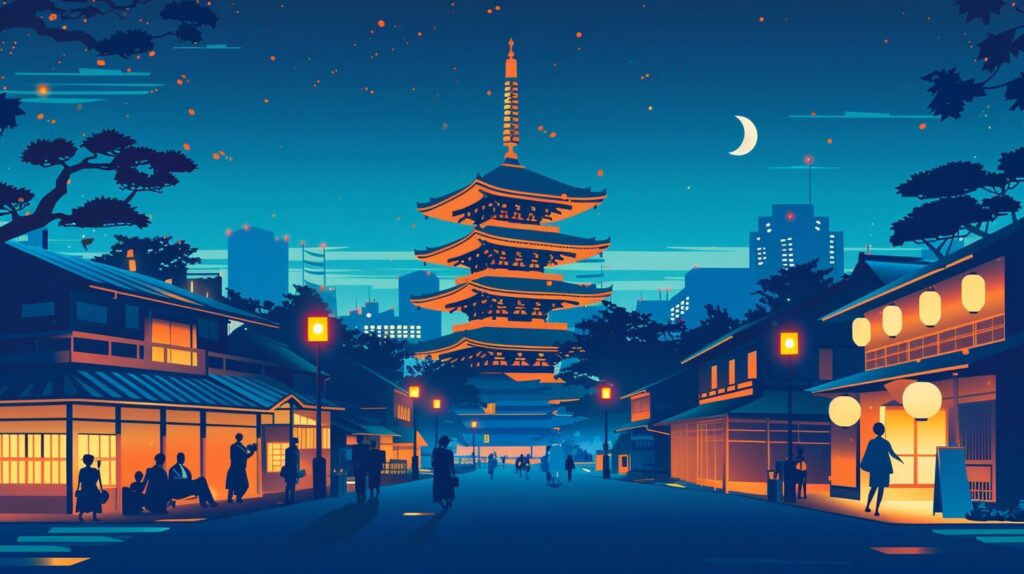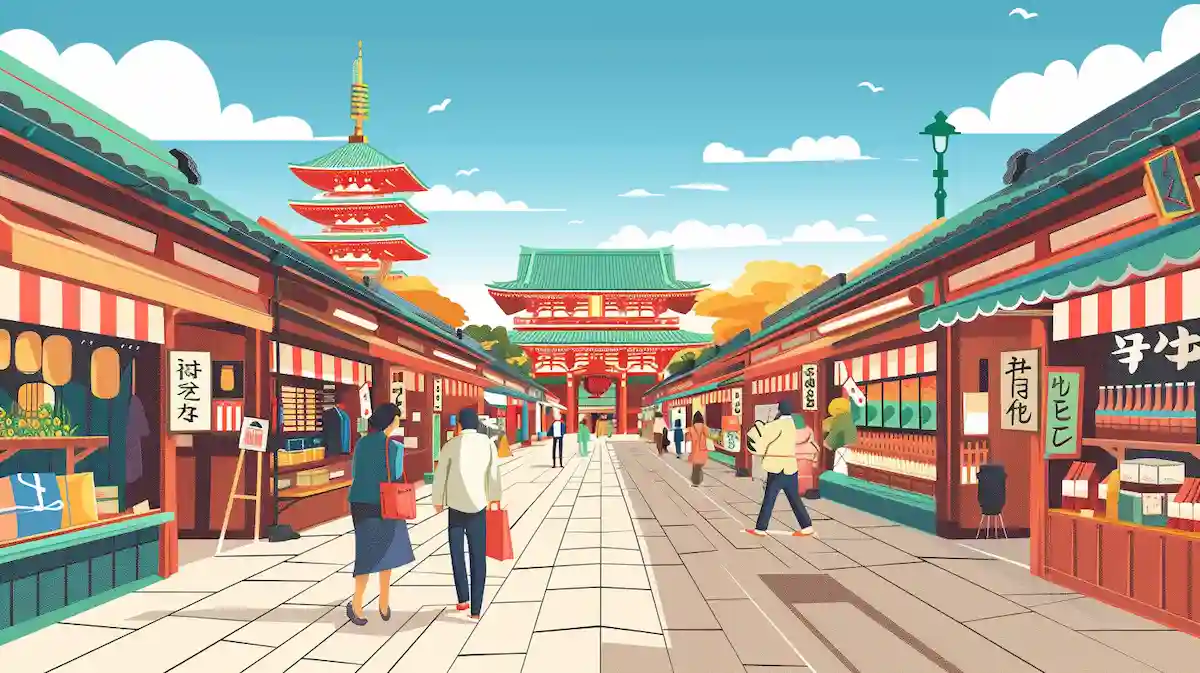浅草寺を英語で説明・紹介するための基本情報と、英会話に役立つ表現をシンプルでわかりやすい英語で紹介します。
英会話ダイアローグ・関連情報・10の質問を通して、浅草寺に関する英語表現を学びます。
英語
英会話ダイアローグを読む前に知っておくと良い前提知識と情報です。
- 浅草寺の歴史:
- 東京で最も古い寺院、628年に創建
- 観音菩薩を祀っている
- 雷門:
- 浅草寺の入口にある有名な門
- 大きな赤い提灯と風神・雷神の像が特徴
- 仲見世通り:
- 雷門から本堂へ続く約250メートルの参道
- 人形焼きや雷おこしなどの伝統的なお菓子やお土産を買える
- 三社祭:
- 毎年5月に行われる浅草神社のお祭り
- 五重塔と伝法院庭園:
- 浅草寺の本堂の近くに五重塔、寺の裏手に静かな日本庭園がえる
2人が浅草寺について話しています。
浅草寺の歴史、象徴的な雷門、仲見世通り、有名な祭り、五重塔や庭園など、見どころや魅力などを話題にしています。
会話 / dialogue

Hey Key, I’ve been really interested in Sensō-ji lately. Have you ever been?

Yes, I have! Sensō-ji is one of the most fascinating places in Tokyo. What caught your interest?

I heard it’s the oldest temple in Tokyo, founded way back in 628 AD. The history alone makes it worth a visit, don’t you think?

Absolutely. The history is rich, and you can really feel it when you’re there. The Kaminarimon, or Thunder Gate, is a must-see. It’s the entrance to Sensō-ji and has this massive red lantern that’s about 4 meters tall.

I’ve seen pictures of that! And aren’t there statues of the wind and thunder gods there too?

Exactly. The statues are on either side of the gate, and they’re quite impressive. After you pass through the Kaminarimon, you’ll find yourself on Nakamise Street. It’s a 250-meter long shopping street that’s been around since the Edo period.

Oh, that sounds like a great place to pick up some souvenirs. What kind of things do they sell there?

You’ll find all sorts of traditional Japanese items—souvenirs, handmade crafts, snacks like ningyo-yaki and kaminari-okoshi. It’s really fun to explore.

I’m definitely going to spend some time there. What about events? I heard Sensō-ji has some famous festivals.

Yes, the Sanja Matsuri in May is the most famous. It’s one of Tokyo’s biggest festivals, and the whole area gets so lively. There’s also the Hozuki Market in July and the Hagoita Market in December, both worth checking out.

That sounds amazing. I’d love to experience the Sanja Matsuri. What else should I look out for when visiting?

The five-story pagoda is beautiful, and if you have time, the Denboin Garden behind the temple is a peaceful spot, especially in the autumn when the leaves change color.

I didn’t know about the garden. I’ll have to check it out. What do you think makes Sensō-ji so special compared to other temples?

I think it’s a combination of its deep history, the lively atmosphere, especially around Nakamise Street, and its cultural significance. Plus, it’s so accessible from anywhere in Tokyo.

You’re right. The fact that it’s so easy to get to makes it even more appealing. I can’t wait to visit and see all these things for myself.

You’ll love it, Mack. Just be prepared for crowds, especially during the festivals, but that’s part of the charm too.

I’m sure it is. Thanks for all the tips, Key. I’m more excited than ever to visit Sensō-ji now.

Anytime! Enjoy your visit, and don’t forget to take a photo at the Kaminarimon!

Definitely. I’ll send you one when I’m there!

I’ll look forward to it. Have fun!
関連情報 / related information
「浅草寺」について、理解を深めるための「英語での関連情報」です。
浅草寺

Introduction to Sensō-ji
Sensō-ji is the oldest and one of the most famous temples in Tokyo, Japan. It was founded in 628 AD and is located in the Asakusa district. The temple is dedicated to Kannon, the Buddhist goddess of mercy. Many people visit Sensō-ji each year to pray and enjoy its historic and cultural atmosphere.
Kaminarimon and Nakamise Street
The entrance to Sensō-ji is marked by the Kaminarimon, or Thunder Gate. This gate has a giant red lantern and statues of the wind and thunder gods. After passing through the Kaminarimon, visitors enter Nakamise Street, a 250-meter long shopping street. Here, you can find traditional Japanese souvenirs and snacks, making it a fun place to explore.
Festivals and Events
Sensō-ji is known for hosting many famous festivals. The most well-known is the Sanja Matsuri, held in May. This festival is one of Tokyo’s biggest and attracts large crowds. Other events include the Hozuki Market in July and the Hagoita Market in December.
Special Features
Sensō-ji also has a beautiful five-story pagoda and the peaceful Denboin Garden. The temple is easily accessible from anywhere in Tokyo, making it a popular destination for both locals and tourists. Visiting Sensō-ji offers a rich experience of Japanese history and culture.
10の質問 / 10 questions
「浅草寺」について、理解を深めるための「英語での10の質問」です。
1: What is Sensō-ji?
Sensō-ji is the oldest temple in Tokyo, founded in 628 AD. It is dedicated to Kannon, the Buddhist goddess of mercy, and is located in the Asakusa district.
2: What is the Kaminarimon?
The Kaminarimon, also known as the Thunder Gate, is the iconic entrance to Sensō-ji. It features a giant red lantern and statues of the wind and thunder gods.
3: What can you find on Nakamise Street?
Nakamise Street is a 250-meter shopping street leading to Sensō-ji. It is lined with shops selling traditional Japanese souvenirs, snacks, and crafts.
4: When is the Sanja Matsuri held?
The Sanja Matsuri is held in May every year. It is one of Tokyo’s biggest and most lively festivals, attracting large crowds.
5: What is special about the five-story pagoda at Sensō-ji?
The five-story pagoda is a beautiful and iconic structure located near the main hall of Sensō-ji. It is one of the temple’s most photographed features.
6: What is the Denboin Garden?
The Denboin Garden is a peaceful Japanese garden located behind Sensō-ji. It is known for its beautiful scenery, especially during the autumn season.
7: Why is Sensō-ji a popular destination?
Sensō-ji is popular because of its deep history, cultural significance, and the lively atmosphere around it. It’s also easy to access from anywhere in Tokyo.
8: What is sold at the Hozuki Market?
The Hozuki Market, held in July, sells hozuki plants (Chinese lantern plants). It is a traditional event that attracts many visitors to Sensō-ji.
9: What is the Hagoita Market?
The Hagoita Market is held in December at Sensō-ji. It sells decorative paddles called hagoita, which are often used as New Year’s decorations.
10: How does Sensō-ji contribute to Japanese culture?
Sensō-ji contributes to Japanese culture by preserving its ancient traditions, hosting important festivals, and being a place where people can connect with the country’s spiritual and cultural heritage.

和訳付
会話 / dialogue

Hey Key, I’ve been really interested in Sensō-ji lately. Have you ever been?
ねえキー、最近浅草寺にすごく興味があるんだ。行ったことある?

Yes, I have! Sensō-ji is one of the most fascinating places in Tokyo. What caught your interest?
あるよ!浅草寺は東京でも特に面白い場所の一つだよ。何が興味を引いたの?

I heard it’s the oldest temple in Tokyo, founded way back in 628 AD. The history alone makes it worth a visit, don’t you think?
東京で一番古い寺で、628年に建てられたって聞いたんだ。その歴史だけでも訪れる価値があると思わない?

Absolutely. The history is rich, and you can really feel it when you’re there. The Kaminarimon, or Thunder Gate, is a must-see. It’s the entrance to Sensō-ji and has this massive red lantern that’s about 4 meters tall.
もちろんだよ。歴史が深くて、そこに行くと本当に感じられるんだ。雷門、つまり「かみなりもん」は必見だよ。浅草寺の入口で、高さが4メートルもある大きな赤い提灯が吊り下がってるんだ。

I’ve seen pictures of that! And aren’t there statues of the wind and thunder gods there too?
それの写真を見たことあるよ!風神と雷神の像もあるんだよね?

Exactly. The statues are on either side of the gate, and they’re quite impressive. After you pass through the Kaminarimon, you’ll find yourself on Nakamise Street. It’s a 250-meter long shopping street that’s been around since the Edo period.
その通り。像は門の両側にあって、かなり迫力があるよ。雷門を通り抜けると仲見世通りに出るんだ。江戸時代から続いている250メートルほどのショッピングストリートだよ。

Oh, that sounds like a great place to pick up some souvenirs. What kind of things do they sell there?
お土産を買うには絶好の場所みたいだね。どんなものが売ってるの?

You’ll find all sorts of traditional Japanese items—souvenirs, handmade crafts, snacks like ningyo-yaki and kaminari-okoshi. It’s really fun to explore.
いろんな伝統的な日本のアイテムが見つかるよ。お土産、手作りの工芸品、にんぎょう焼きや雷おこしみたいなお菓子とかね。歩いてるだけでもすごく楽しいよ。

I’m definitely going to spend some time there. What about events? I heard Sensō-ji has some famous festivals.
そこには時間をかけて回りたいな。イベントはどう?浅草寺には有名なお祭りがあるって聞いたんだけど。

Yes, the Sanja Matsuri in May is the most famous. It’s one of Tokyo’s biggest festivals, and the whole area gets so lively. There’s also the Hozuki Market in July and the Hagoita Market in December, both worth checking out.
うん、5月の三社祭が一番有名だよ。東京でも最大級のお祭りの一つで、エリア全体がすごく賑やかになるんだ。7月にはほおずき市、12月には羽子板市もあって、どちらも見る価値があるよ。

That sounds amazing. I’d love to experience the Sanja Matsuri. What else should I look out for when visiting?
それはすごいね。三社祭を体験してみたいよ。他に行くときに注目すべきものってある?

The five-story pagoda is beautiful, and if you have time, the Denboin Garden behind the temple is a peaceful spot, especially in the autumn when the leaves change color.
五重塔は美しいし、もし時間があれば、寺の裏手にある伝法院庭園もおすすめだよ。特に秋の紅葉の季節はとても静かでいい場所だよ。

I didn’t know about the garden. I’ll have to check it out. What do you think makes Sensō-ji so special compared to other temples?
庭園のことは知らなかったよ。ぜひチェックしないとね。他のお寺と比べて、浅草寺が特別な理由は何だと思う?

I think it’s a combination of its deep history, the lively atmosphere, especially around Nakamise Street, and its cultural significance. Plus, it’s so accessible from anywhere in Tokyo.
深い歴史、特に仲見世通り周辺の活気ある雰囲気、そして文化的な重要性が合わさってるからだと思うよ。それに、東京のどこからでも行きやすいしね。

You’re right. The fact that it’s so easy to get to makes it even more appealing. I can’t wait to visit and see all these things for myself.
その通りだね。行きやすいっていうのも魅力的だよね。早く行って、実際に全部見てみたいよ。

You’ll love it, Mack. Just be prepared for crowds, especially during the festivals, but that’s part of the charm too.
きっと気に入るよ、マック。特にお祭りの時期は混雑するけど、それもまた魅力の一部だよ。

I’m sure it is. Thanks for all the tips, Key. I’m more excited than ever to visit Sensō-ji now.
そうだね。いろいろ教えてくれてありがとう、キー。ますます浅草寺に行くのが楽しみになったよ。

Anytime! Enjoy your visit, and don’t forget to take a photo at the Kaminarimon!
いつでもどういたしまして!浅草寺を楽しんでね、そして雷門で写真を撮るのを忘れないでね!

Definitely. I’ll send you one when I’m there!
もちろんさ。行ったら写真を送るよ!

I’ll look forward to it. Have fun!
楽しみにしてるよ。楽しんでね!
関連情報 / related information
浅草寺

Introduction to Sensō-ji
Sensō-ji is the oldest and one of the most famous temples in Tokyo, Japan. It was founded in 628 AD and is located in the Asakusa district. The temple is dedicated to Kannon, the Buddhist goddess of mercy. Many people visit Sensō-ji each year to pray and enjoy its historic and cultural atmosphere.
浅草寺は、東京で最も古く、最も有名な寺院の一つです。628年に創建され、浅草地区に位置しています。この寺院は、観音菩薩を祀っています。毎年多くの人々が浅草寺を訪れ、祈りを捧げ、その歴史的で文化的な雰囲気を楽しんでいます。
Kaminarimon and Nakamise Street
The entrance to Sensō-ji is marked by the Kaminarimon, or Thunder Gate. This gate has a giant red lantern and statues of the wind and thunder gods. After passing through the Kaminarimon, visitors enter Nakamise Street, a 250-meter long shopping street. Here, you can find traditional Japanese souvenirs and snacks, making it a fun place to explore.
浅草寺の入口には、雷門(かみなりもん)があります。この門には巨大な赤い提灯と風神雷神の像があります。雷門を通り抜けると、仲見世通りという250メートルにわたるショッピングストリートに出ます。ここでは、伝統的な日本のお土産やお菓子が手に入り、散策が楽しい場所です。
Festivals and Events
Sensō-ji is known for hosting many famous festivals. The most well-known is the Sanja Matsuri, held in May. This festival is one of Tokyo’s biggest and attracts large crowds. Other events include the Hozuki Market in July and the Hagoita Market in December.
浅草寺は、数々の有名な祭りを開催することで知られています。最も有名なのは、5月に行われる三社祭です。この祭りは東京最大級の祭りの一つで、大勢の人々が訪れます。その他には、7月のほおずき市や12月の羽子板市などもあります。
Special Features
Sensō-ji also has a beautiful five-story pagoda and the peaceful Denboin Garden. The temple is easily accessible from anywhere in Tokyo, making it a popular destination for both locals and tourists. Visiting Sensō-ji offers a rich experience of Japanese history and culture.
浅草寺には、美しい五重塔と静かな伝法院庭園もあります。この寺院は東京のどこからでもアクセスしやすく、地元の人々や観光客に人気のある観光地です。浅草寺を訪れることで、日本の歴史や文化を豊かに体験することができます。
10の質問 / 10 questions
1: What is Sensō-ji?
浅草寺とは何ですか?
Sensō-ji is the oldest temple in Tokyo, founded in 628 AD. It is dedicated to Kannon, the Buddhist goddess of mercy, and is located in the Asakusa district.
浅草寺は東京で最も古い寺院で、628年に創建されました。観音菩薩を祀っており、浅草地区にあります。
2: What is the Kaminarimon?
雷門とは何ですか?
The Kaminarimon, also known as the Thunder Gate, is the iconic entrance to Sensō-ji. It features a giant red lantern and statues of the wind and thunder gods.
雷門は「かみなりもん」としても知られ、浅草寺の象徴的な入口です。巨大な赤い提灯と風神雷神の像が特徴です。
3: What can you find on Nakamise Street?
仲見世通りでは何が見つかりますか?
Nakamise Street is a 250-meter shopping street leading to Sensō-ji. It is lined with shops selling traditional Japanese souvenirs, snacks, and crafts.
仲見世通りは浅草寺へ続く250メートルのショッピングストリートです。伝統的な日本のお土産やお菓子、工芸品を販売する店が並んでいます。
4: When is the Sanja Matsuri held?
三社祭はいつ開催されますか?
The Sanja Matsuri is held in May every year. It is one of Tokyo’s biggest and most lively festivals, attracting large crowds.
三社祭は毎年5月に開催されます。東京でも最大級で、最も活気のある祭りの一つで、多くの人々が訪れます。
5: What is special about the five-story pagoda at Sensō-ji?
浅草寺の五重塔は何が特別ですか?
The five-story pagoda is a beautiful and iconic structure located near the main hall of Sensō-ji. It is one of the temple’s most photographed features.
五重塔は浅草寺の本堂近くにある美しく象徴的な建物です。寺院で最も写真に撮られる場所の一つです。
6: What is the Denboin Garden?
伝法院庭園とは何ですか?
The Denboin Garden is a peaceful Japanese garden located behind Sensō-ji. It is known for its beautiful scenery, especially during the autumn season.
伝法院庭園は浅草寺の裏手にある静かな日本庭園です。特に秋の季節に美しい景色で知られています。
7: Why is Sensō-ji a popular destination?
浅草寺が人気の観光地である理由は何ですか?
Sensō-ji is popular because of its deep history, cultural significance, and the lively atmosphere around it. It’s also easy to access from anywhere in Tokyo.
浅草寺はその深い歴史、文化的な重要性、そして周辺の活気ある雰囲気で人気です。また、東京のどこからでもアクセスしやすいです。
8: What is sold at the Hozuki Market?
ほおずき市では何が売られていますか?
The Hozuki Market, held in July, sells hozuki plants (Chinese lantern plants). It is a traditional event that attracts many visitors to Sensō-ji.
7月に開催されるほおずき市では、ほおずきの鉢植えが販売されます。これは多くの人々が浅草寺を訪れる伝統的なイベントです。
9: What is the Hagoita Market?
羽子板市とは何ですか?
The Hagoita Market is held in December at Sensō-ji. It sells decorative paddles called hagoita, which are often used as New Year’s decorations.
羽子板市は12月に浅草寺で開催されます。羽子板と呼ばれる装飾された板が販売され、これはお正月の飾りとしてよく使われます。
10: How does Sensō-ji contribute to Japanese culture?
浅草寺は日本文化にどのように貢献していますか?
Sensō-ji contributes to Japanese culture by preserving its ancient traditions, hosting important festivals, and being a place where people can connect with the country’s spiritual and cultural heritage.
浅草寺は、古くからの伝統を守り、重要な祭りを開催し、人々が日本の精神的および文化的遺産とつながる場所であることで、日本文化に貢献しています。

words & phrases
英会話ダイアローグと関連情報に出てきた単語・フレーズです(例文は各3つ)。

fascinating : 形容詞
意味: 魅力的な、心を引きつける。Extremely interesting and attractive.
(浅草寺が東京で最も興味深い場所の一つであることを指す)
例文:
- The history of Sensō-ji is absolutely fascinating.
「浅草寺の歴史は本当に魅力的です。」 - She told a fascinating story about her travels.
「彼女は旅行についてのとても興味深い話をしてくれました。」 - The museum’s exhibition was fascinating to all the visitors.
「博物館の展示は全ての訪問者にとって魅力的でした。」
massive : 形容詞
意味: 非常に大きい、巨大な。Very large, heavy, and solid.
(雷門の巨大な赤い提灯を指す)
例文:
- The Kaminarimon has a massive red lantern.
「雷門には巨大な赤い提灯があります。」 - They built a massive bridge over the river.
「彼らは川に巨大な橋を建設しました。」 - The earthquake caused massive damage to the city.
「地震は都市に甚大な被害をもたらしました。」
pagoda : 名詞
意味: 仏塔。A tiered tower with multiple eaves, often found in Buddhist temples.
(浅草寺の象徴的な五重塔を指す)
例文:
- The five-story pagoda at Sensō-ji is very iconic.
「浅草寺の五重塔はとても象徴的です。」 - We visited a beautiful pagoda in Kyoto.
「私たちは京都の美しい仏塔を訪れました。」 - The pagoda is surrounded by a serene garden.
「その仏塔は静かな庭園に囲まれています。」
district : 名詞
意味: 地区、地域。An area of a city or country, especially one with a particular characteristic or function.
(浅草地区を指す)
例文:
- Sensō-ji is located in the Asakusa district.
「浅草寺は浅草地区にあります。」 - The shopping district was crowded with people.
「ショッピング地区は人々で混雑していました。」 - They live in a quiet district of the city.
「彼らは市内の静かな地区に住んでいます。」
dedicated : 形容詞
意味: 専念した、献身的な、~に捧げられた。Devoted to a task or purpose; exclusively allocated to or intended for a particular purpose.
(浅草寺が観音菩薩に捧げられていることを指す)
例文:
- Sensō-ji is dedicated to Kannon, the Buddhist goddess of mercy.
「浅草寺は観音菩薩に捧げられています。」 - She is dedicated to her work and often stays late at the office.
「彼女は仕事に専念しており、よく遅くまでオフィスに残っています。」 - The new park is dedicated to the memory of the town’s founder.
「新しい公園は町の創設者の記念に捧げられています。」
